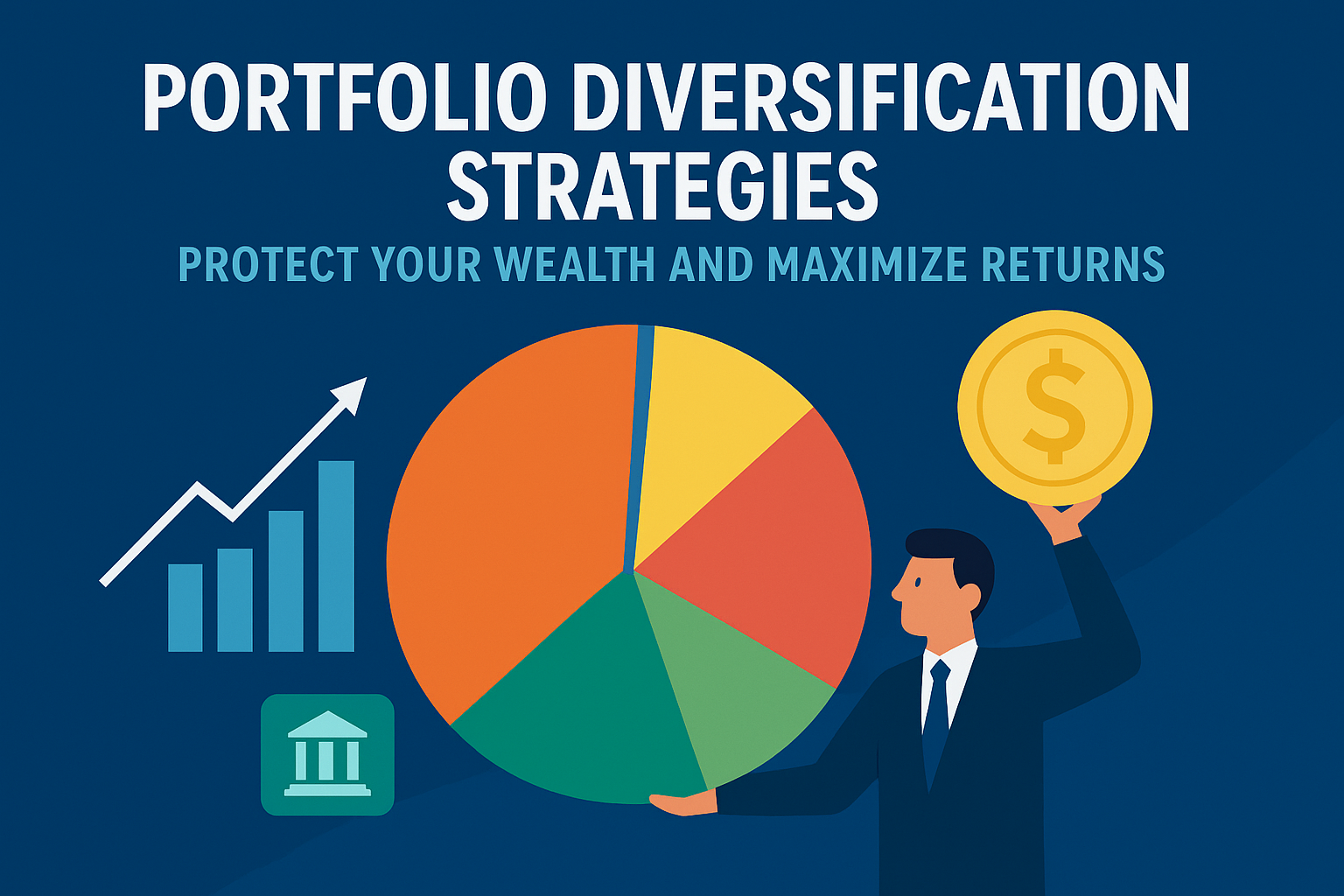Every seasoned investor knows the golden rule of investing: “Don’t put all your eggs in one basket.”
In the financial world, that basket is your portfolio, and the eggs are your investments. By diversifying your portfolio, you spread your investments across different assets to reduce risk and increase the potential for stable returns.
But diversification isn’t just about buying different stocks—it’s a strategic balance of asset classes, sectors, geographies, and investment styles.
That’s where the best financial advisor for a diversified investment portfolio can make a difference—helping you build a portfolio that protects your wealth during downturns and maximizes gains during growth phases.
In this article, we’ll explore:
- What diversification really means
- Types of diversification strategies
- How to choose the right mix of assets
- Common mistakes to avoid
- How expert advice can elevate your investment success
What is Portfolio Diversification?
Portfolio diversification is an investment strategy that involves spreading your capital across a variety of assets to minimize risk. The goal is to avoid a situation where poor performance in one investment significantly impacts your overall wealth.
Example:
If your entire portfolio is invested in tech stocks and the sector crashes, your losses will be massive. But if your investments are spread across equities, bonds, gold, and real estate, the losses in one area can be offset by gains in another.
Why Diversification Matters
1. Risk Reduction
Different asset classes react differently to market events. Diversification helps ensure that no single downturn wipes out your wealth.
2. Smoother Returns
A diversified portfolio tends to have more stable returns over time, even in volatile markets.
3. Exposure to Growth Opportunities
By investing in multiple sectors and markets, you tap into various growth avenues.
4. Psychological Comfort
A well-diversified portfolio reduces anxiety during market swings, helping investors stick to their long-term plans.
Core Principles of Diversification
Before diving into strategies, it’s essential to understand the basic principles:
- Spread Across Asset Classes – Don’t limit yourself to just equities or bonds.
- Balance Risk and Reward – High-growth assets should be balanced with stable ones.
- Consider Correlation – Choose assets that don’t move in the same direction.
- Rebalance Regularly – Your allocation should be adjusted over time based on market conditions and personal goals.
Types of Portfolio Diversification
1. Asset Class Diversification
Invest across equities, fixed income, real estate, commodities, and cash equivalents to balance growth and stability.
Example Allocation:
- 50% Equity (stocks, equity mutual funds)
- 30% Debt (bonds, fixed deposits)
- 10% Commodities (gold, silver)
- 10% Real Estate
2. Sector Diversification
Spread your equity investments across sectors like technology, healthcare, energy, finance, and consumer goods.
Why it works: Different sectors perform differently in various economic cycles.
3. Geographic Diversification
Invest in both domestic and international markets to reduce country-specific risks.
Example:
A slowdown in the Indian economy might be offset by strong performance in the US or emerging markets.
4. Market Capitalization Diversification
Balance your stock investments between large-cap, mid-cap, and small-cap companies.
- Large-Cap: Stability, lower volatility
- Mid-Cap: Balanced risk-return
- Small-Cap: High growth potential, higher volatility
5. Investment Style Diversification
Mix growth investing (companies with high earnings potential) and value investing (undervalued companies with strong fundamentals).
6. Time Horizon Diversification
Align investments with short-term, medium-term, and long-term goals, so you’re not forced to exit investments prematurely.
Building a Diversified Investment Portfolio
Step 1: Assess Your Risk Tolerance
An aggressive investor might have 70% equities, while a conservative investor might prefer 40% equities and 60% bonds.
Step 2: Define Your Financial Goals
Your asset mix will vary depending on whether your goal is wealth creation, retirement planning, or generating passive income.
Step 3: Select the Right Asset Classes
Choose a blend of equities, debt, commodities, and alternative investments based on your goals and risk profile.
Step 4: Allocate Within Asset Classes
Diversify within each asset class—different sectors, geographies, and styles.
Step 5: Monitor and Rebalance
Market movements can skew your allocation. Rebalancing every 6–12 months keeps your portfolio aligned with your strategy.
Example: Diversified Portfolio for a Moderate Investor
| Asset Class | Allocation | Examples |
|---|---|---|
| Equity | 50% | Large-cap mutual funds, mid-cap stocks |
| Debt | 30% | Government bonds, fixed deposits |
| Commodities | 10% | Gold ETFs, silver |
| Real Estate | 10% | REITs or property investment |
Benefits of Working with the Best Financial Advisor for a Diversified Investment Portfolio
An expert advisor can:
- Identify Optimal Asset Allocation – Based on your goals, timeline, and risk appetite.
- Recommend High-Quality Investments – Selecting top-performing mutual funds, ETFs, bonds, and stocks.
- Implement Tax-Efficient Strategies – Minimizing tax liability while maximizing returns.
- Provide Market Insights – Helping you navigate changing economic and market conditions.
- Offer Emotional Discipline – Preventing panic selling during market downturns.
Common Mistakes in Diversification
- Over-Diversification – Spreading investments too thin can dilute returns.
- Ignoring Correlation – Holding multiple investments that move the same way defeats the purpose.
- Set and Forget Approach – Failing to rebalance can lead to unintended risk exposure.
- Chasing Hot Sectors – Concentrating too much in trending sectors increases volatility.
Real-World Example: How Diversification Protects Wealth
Imagine two investors in 2020 when the COVID-19 pandemic hit:
- Investor A: 100% invested in airline stocks. Loss: -60% in 3 months.
- Investor B: Diversified across airlines, tech, healthcare, and gold. While airlines fell, tech and gold surged, limiting overall loss to -8%.
Diversification Myths Busted
- Myth: Diversification guarantees profits.
Truth: It reduces risk but doesn’t eliminate it. - Myth: More investments mean better diversification.
Truth: Quality matters more than quantity. - Myth: Diversification is only for large portfolios.
Truth: Even small investors can diversify using mutual funds or ETFs.
Advanced Diversification Strategies
1. Factor Investing
Invest based on factors like value, momentum, volatility, and quality.
2. Hedging with Derivatives
Use options or futures to protect against downside risks.
3. Alternative Investments
Include private equity, venture capital, or art for uncorrelated returns.
Tax Considerations in Diversified Portfolios
- Equity gains taxed as STCG or LTCG based on holding period.
- Debt instruments taxed as per income slab.
- International investments may have additional tax treaties and implications.
Tip: Work with a financial advisor to structure your portfolio tax-efficiently.
The Role of Technology in Diversification
Modern tools allow advisors to:
- Track portfolio performance in real time.
- Analyze correlations and risk metrics.
- Simulate various market scenarios to stress-test portfolios.
Final Thoughts
Diversification is not just an investment tactic—it’s a wealth protection philosophy. The right mix of assets shields you from market shocks while positioning you for steady growth.
However, achieving true diversification requires expert knowledge, disciplined monitoring, and strategic adjustments. That’s where the best financial advisor for a diversified investment portfolio becomes your most valuable ally.
Call-to-Action
Ready to build a diversified investment portfolio that protects your wealth and maximizes returns?
Contact us today to speak with the best financial advisor for a diversified investment portfolio and get a customized investment strategy tailored to your goals.


Leave a Reply